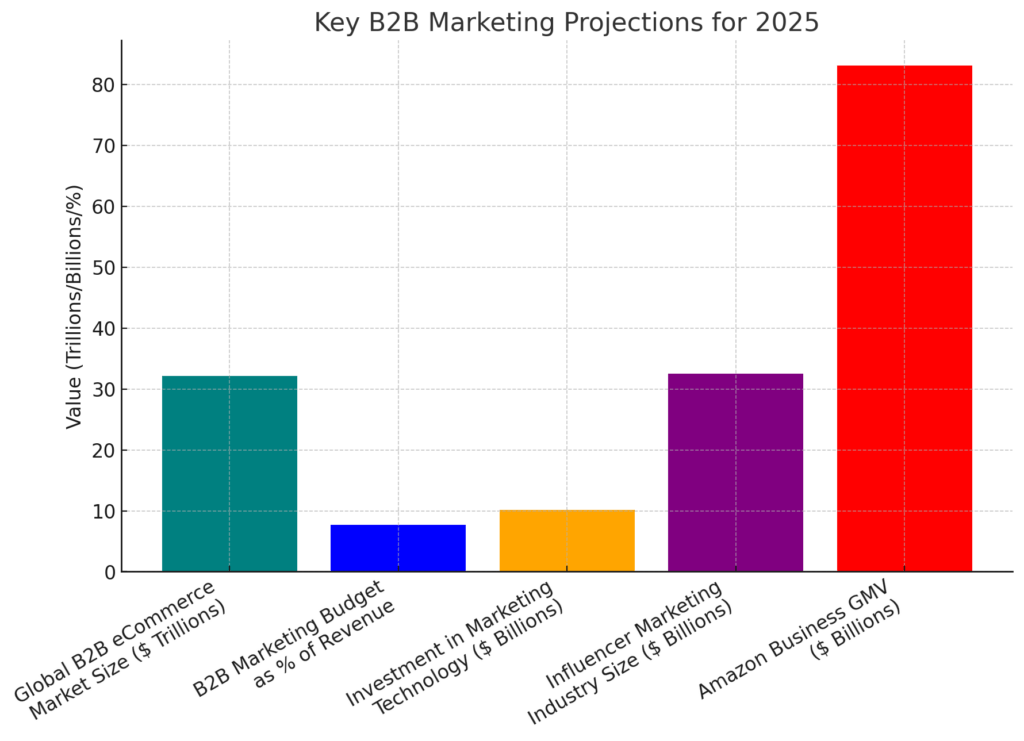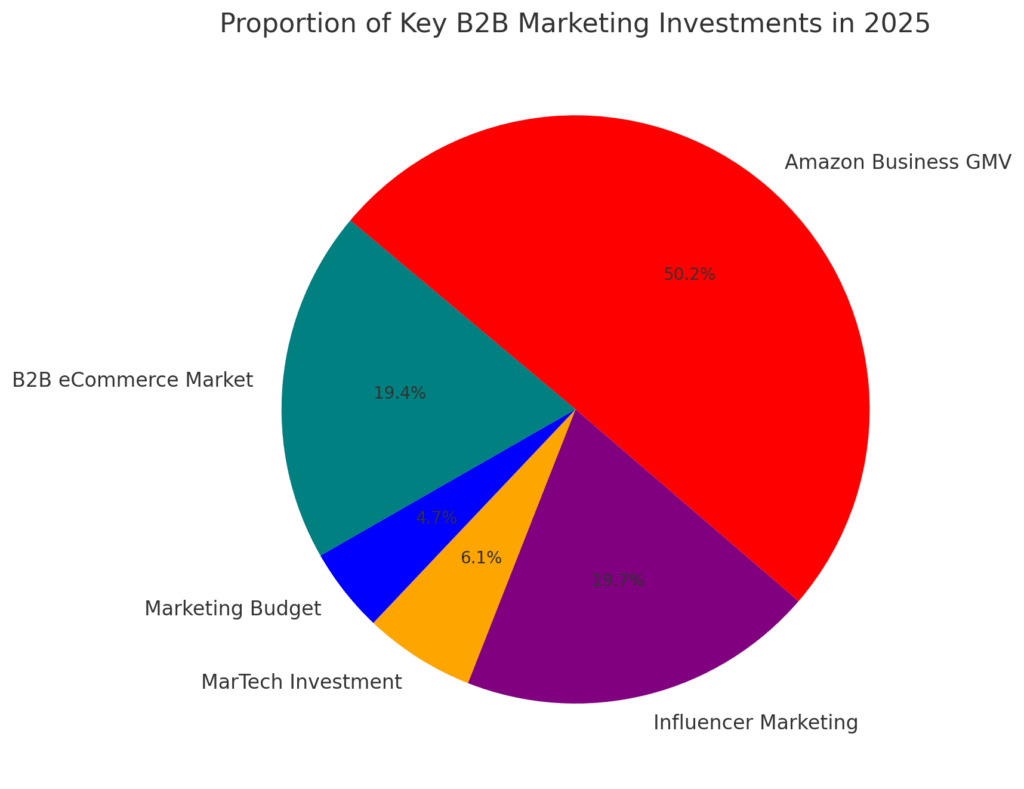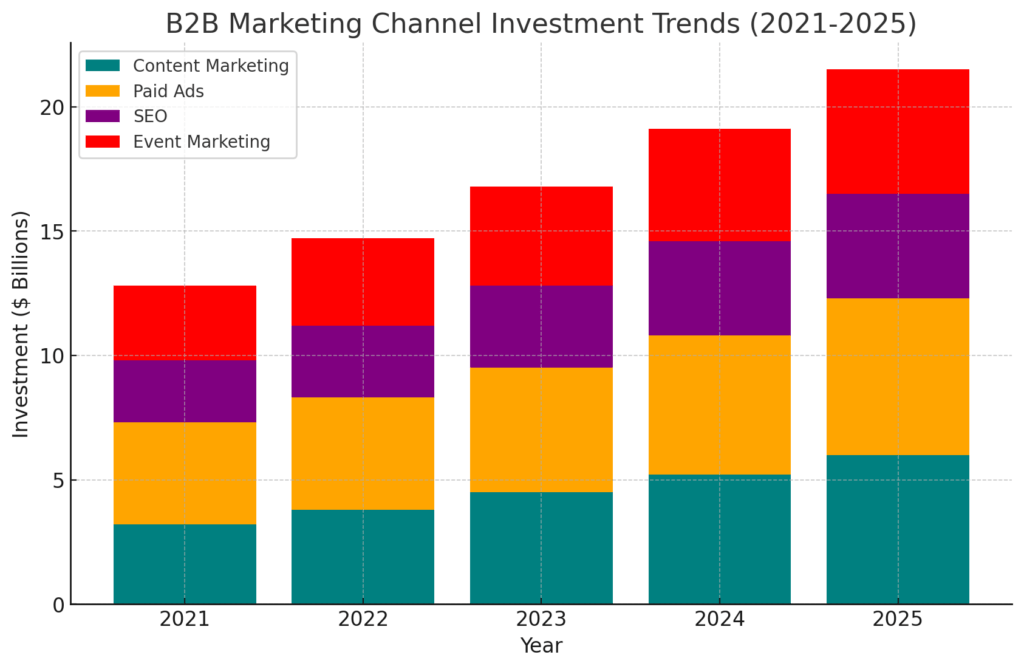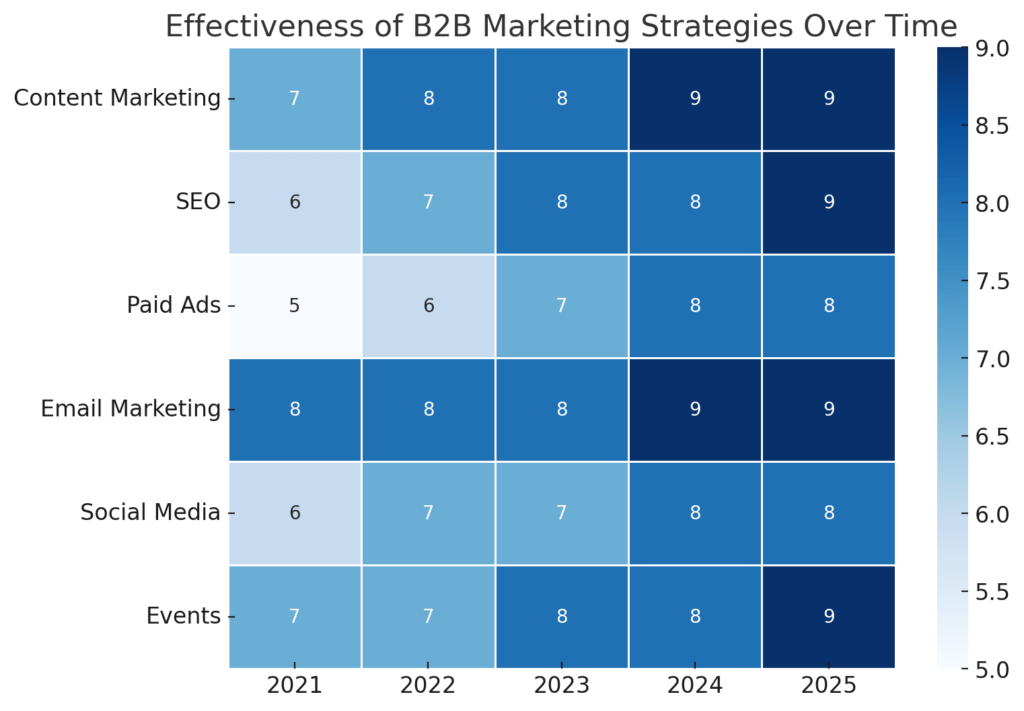
24 Mar BEST B2B MARKETING STATISTICS 2025
B2B marketing is evolving rapidly, driven by digital transformation, AI integration, and changing buyer behaviors. Businesses are shifting toward data-driven strategies, automation, and personalized engagement to stay competitive in an increasingly digital-first environment. As companies allocate more resources to marketing technology, content creation, and eCommerce, the ability to adapt to emerging trends will determine long-term success. From the growing dominance of LinkedIn to the rising influence of AI-driven analytics, these statistics reveal the key forces shaping the future of B2B marketing. Amra and Elma recognizes that understanding these insights can help businesses refine their strategies, optimize their marketing spend, and build stronger relationships with their target audiences. The following 20 statistics offer a comprehensive look at where B2B marketing stands today and where it’s headed in 2025.
BEST B2B MARKETING STATISTICS 2025 (Editor’s Choice)
Here are 20 essential B2B marketing statistics, reflecting both historical trends and projections for 2025:
1. Global B2B eCommerce Market Size: The global B2B eCommerce market is projected to reach $32.11 trillion by 2025, with a compound annual growth rate (CAGR) of 14.5%.
2. Digital Channels Preference: Approximately 64% of modern B2B buyers prefer digital channels over traditional methods.
3. Content Marketing Focus: A significant 83% of B2B content aims to build brand awareness and interest.
4. Long-Form Content for SEO: Content averaging around 1,447 words tends to rank on Google’s first page, indicating the value of in-depth material.
5. Outsourcing Content Creation: About 84% of businesses outsource their content creation to ensure quality and consistency.
6. Video Marketing Investment: In 2025, 87% of B2B marketers plan to invest in video marketing, recognizing its growing importance.
7. Content Marketing Effectiveness: Content marketing has led to 83% of B2B marketers achieving brand awareness goals, with 77% building trust and credibility.
8. AI Integration: In 2025, 40% of B2B marketers expect to increase investment in AI for content optimization and performance, while 39% plan to invest in AI for content creation.
9. In-Person Events and Webinars: In-person events (52%) and webinars (51%) are considered the most effective distribution channels by B2B marketers.
10. Paid Channels Usage: Approximately 84% of B2B marketers utilize paid channels, with 73% using social media advertising/promoted posts.
11. Search Engine Marketing (SEM) Effectiveness: SEM/PPC is reported to produce the best results among paid channels, with 61% of B2B marketers affirming its effectiveness.
12. LinkedIn’s Value: A substantial 85% of B2B marketers cite LinkedIn as delivering the best value among social media platforms.
13. Marketing Budget Allocation: In 2024, B2B companies allocated 7.5% of their total revenue to marketing, with expectations to increase to 7.7% in 2025.
14. Influencer Marketing Growth: The influencer marketing industry is projected to reach $32.55 billion by 2025, reflecting its growing significance in B2B strategies.
15. MarTech Spending: B2B companies are expected to spend $10.11 billion on marketing technology in 2025, indicating a steady annual growth.
16. Amazon Business Growth: Amazon Business’s gross merchandise volume is projected to reach $83.1 billion by 2025, showcasing the platform’s expanding role in B2B eCommerce.
17. Cross-Border B2B Payments: The value of cross-border B2B payments is expected to increase to $56.1 trillion by 2030, highlighting globalization in B2B transactions.
18. Trade Show Market: The U.S. trade show market is projected to reach $17.4 billion by 2028, emphasizing the enduring importance of face-to-face marketing.
19. AI Optimism: Approximately 58% of B2B marketers are optimistic about adopting AI in their marketing strategies in the coming years.
20. Email Marketing Conversion Rates: Email marketing remains effective, with a 2.4% conversion rate for B2B brands.
These statistics underscore the dynamic nature of B2B marketing, highlighting the increasing importance of digital channels, AI integration, and content marketing in 2025.

BEST B2B MARKETING STATISTICS 2025 and Future Implications
BEST B2B MARKETING STATISTICS 2025 #1. Global B2B eCommerce Market Size
The global B2B eCommerce market is projected to reach $32.11 trillion by 2025, reflecting the accelerating digital transformation across industries. Companies are shifting their focus from traditional sales channels to digital platforms that offer greater efficiency and scalability. This growth is driven by the increasing adoption of self-service portals, AI-driven recommendations, and automated procurement systems. Businesses that fail to adapt to the digital shift risk losing competitiveness, as buyers now expect seamless online experiences. The rise of B2B marketplaces such as Amazon Business and Alibaba further intensifies competition. To stay ahead, companies must invest in personalized digital experiences, data-driven decision-making, and automation. The next phase of B2B eCommerce will likely involve deeper AI integration, enhancing predictive analytics and customer engagement strategies.
BEST B2B MARKETING STATISTICS 2025 #2. Digital Channels Preference
Approximately 64% of modern B2B buyers prefer digital channels over traditional methods, signaling a permanent shift in purchasing behavior. The pandemic accelerated this trend, making digital-first interactions the norm. Buyers now conduct extensive research online before engaging with sales representatives, emphasizing the need for strong digital content strategies. This shift requires businesses to optimize websites, invest in search engine visibility, and leverage AI-driven chatbots to provide real-time support. Companies that still rely on outdated sales tactics risk falling behind as decision-makers increasingly seek frictionless online transactions. Digital channels also facilitate more efficient lead nurturing through marketing automation and data analytics. Future B2B sales success will depend on how well businesses integrate digital tools to enhance customer experiences and drive conversions.
BEST B2B MARKETING STATISTICS 2025 #3. Content Marketing Focus
A significant 83% of B2B content is designed to build brand awareness and interest, highlighting the critical role of educational and thought leadership materials. Buyers in complex industries require in-depth information before making purchase decisions, making high-quality content an essential part of marketing strategies. This trend underscores the importance of producing blogs, whitepapers, case studies, and research reports that address pain points and industry challenges. Brands that invest in storytelling and problem-solving content will establish themselves as industry leaders, fostering long-term trust. However, the growing competition for attention means that businesses must ensure their content stands out through unique insights and engaging formats. The future of content marketing will likely see an increased emphasis on video, interactive content, and AI-personalized recommendations. Those who fail to evolve their content strategies risk losing relevance in an oversaturated market.
BEST B2B MARKETING STATISTICS 2025 #4. Long-Form Content for SEO
Content averaging around 1,447 words tends to rank higher on Google, reinforcing the need for comprehensive, well-researched material. Shorter, surface-level content is becoming less effective, as search algorithms prioritize in-depth analysis and user engagement. B2B marketers must focus on creating detailed guides, case studies, and reports that offer real value to decision-makers. As search engines continue refining their AI-driven ranking factors, high-quality, authoritative content will be a major differentiator. This trend also highlights the importance of user experience, with well-structured, easily navigable content performing best. Businesses investing in robust SEO strategies will benefit from increased organic traffic and credibility. Moving forward, AI-driven content optimization and semantic search understanding will play a greater role in shaping content strategies.
BEST B2B MARKETING STATISTICS 2025 #5. Outsourcing Content Creation
With 84% of businesses outsourcing content creation, the demand for expert-driven, high-quality content is higher than ever. Companies recognize that maintaining a consistent content pipeline requires specialized skills, from research and writing to SEO optimization. Outsourcing allows businesses to scale content production without overburdening internal teams, ensuring fresh, relevant materials. However, the challenge lies in maintaining brand voice and authenticity when external creators are involved. Brands must establish clear guidelines and workflows to ensure consistency and alignment with strategic goals. As AI-generated content tools improve, there will be a shift toward blending human expertise with machine-assisted efficiency. The companies that strike this balance effectively will maintain a competitive edge in content marketing.

BEST B2B MARKETING STATISTICS 2025 #6. Video Marketing Investment
In 2025, 87% of B2B marketers plan to invest in video marketing, highlighting its increasing role in engagement and lead generation. Video content is particularly effective for demonstrating complex products, offering tutorials, and humanizing brands. As attention spans shrink, businesses must create concise yet impactful video content that resonates with professional audiences. Platforms like LinkedIn and YouTube will continue to be key distribution channels, offering B2B companies opportunities to showcase expertise. AI-powered video personalization and interactive elements will become more prominent, making videos more engaging and tailored to individual users. Live streaming and virtual events will also gain traction, further enhancing audience interaction. Businesses that embrace these trends will see stronger brand engagement and higher conversion rates.
BEST B2B MARKETING STATISTICS 2025 #7. Content Marketing Effectiveness
Content marketing has helped 83% of B2B marketers achieve brand awareness goals, proving its effectiveness in shaping buyer perceptions. Additionally, 77% report that content builds trust and credibility, making it a vital component of long-term customer relationships. Unlike direct advertising, content marketing allows businesses to provide value first, positioning them as industry experts. However, the increasing volume of content means businesses must focus on differentiation through unique insights and high-quality production. AI-driven content personalization and behavioral analytics will play a larger role in optimizing content strategies. Businesses that invest in data-driven storytelling and niche-specific content will see higher engagement and conversion rates. Moving forward, interactive content and AI-powered insights will be key to maintaining content effectiveness.
BEST B2B MARKETING STATISTICS 2025 #8. AI Integration
By 2025, 40% of B2B marketers plan to increase AI investment for content optimization, while 39% will use AI for content creation. AI-driven tools are reshaping how businesses analyze audience preferences and generate relevant content. Predictive analytics, automated insights, and chatbot-driven engagement will further streamline marketing strategies. Companies leveraging AI will gain a competitive advantage in efficiency, personalization, and targeting. However, over-reliance on AI-generated content without human oversight can lead to generic or inauthentic messaging. Striking a balance between automation and human creativity will be crucial for maintaining brand identity. In the coming years, AI will enhance everything from SEO strategies to real-time customer interactions, fundamentally transforming B2B marketing approaches.
BEST B2B MARKETING STATISTICS 2025 #9. In-Person Events and Webinars
With 52% of B2B marketers emphasizing in-person events and 51% prioritizing webinars, hybrid engagement strategies remain vital. While digital marketing has become dominant, face-to-face interactions still hold significant value in building strong relationships. Webinars allow businesses to scale thought leadership while maintaining direct engagement with potential buyers. The combination of virtual and physical events ensures brands can cater to diverse audience preferences. AI-driven event personalization will become more prominent, tailoring content and experiences for attendees. Businesses that integrate both in-person and virtual strategies will maximize lead generation and brand authority. As remote work and digital-first interactions persist, companies must continuously refine event marketing approaches.
BEST B2B MARKETING STATISTICS 2025 #10. Paid Channels Usage
Around 84% of B2B marketers use paid channels, with social media advertising being the most popular at 73%. As organic reach declines on platforms like LinkedIn and Facebook, businesses must invest strategically in paid campaigns. PPC, retargeting ads, and sponsored content help brands cut through the noise and reach targeted decision-makers. However, rising advertising costs and competition require smarter budget allocation and data-driven optimizations. AI-powered ad targeting and real-time bidding strategies will shape the next phase of paid B2B marketing. Brands that effectively balance organic and paid strategies will see better long-term ROI. The future will likely involve even more precise targeting, leveraging behavioral data to reach the right audiences at the right moments.
The Future of B2B Marketing: Adaptation and Innovation
B2B marketing is entering a new era where digital strategies, AI-driven insights, and personalized engagement are becoming the standard. Companies that embrace these shifts will gain a competitive edge, while those relying on outdated methods risk losing relevance. As buyers increasingly prefer self-service digital experiences and data-driven decision-making, businesses must refine their content strategies, invest in marketing technology, and optimize their sales funnels. The rise of AI, influencer marketing, and eCommerce platforms is reshaping how brands connect with their audiences. Moving forward, success in B2B marketing will depend on agility—adapting to changing consumer expectations, leveraging emerging technologies, and staying ahead of industry trends. Those who prioritize innovation will not only capture more leads but also build lasting relationships that drive long-term business growth.
Sources:
- https://www.sellerscommerce.com/blog/b2b-marketing-statistics
- https://www.sellerscommerce.com/blog/b2b-marketing-statistics
- https://www.leadforensics.com/blog/24-must-know-b2b-marketing-statistics-for-2025
- https://www.leadforensics.com/blog/24-must-know-b2b-marketing-statistics-for-2025
- https://www.leadforensics.com/blog/24-must-know-b2b-marketing-statistics-for-2025
- https://www.leadforensics.com/blog/24-must-know-b2b-marketing-statistics-for-2025
- https://www.leadforensics.com/blog/24-must-know-b2b-marketing-statistics-for-2025
- https://contentmarketinginstitute.com/articles/content-marketing-statistics
- https://contentmarketinginstitute.com/articles/b2b-content-marketing-trends-research
- https://contentmarketinginstitute.com/articles/b2b-content-marketing-trends-research
- https://contentmarketinginstitute.com/articles/b2b-content-marketing-trends-research
- https://contentmarketinginstitute.com/articles/b2b-content-marketing-trends-research
- https://cadenaser.com/nacional/2025/01/23/las-empresas-preven-un-crecimiento-de-las-ventas-de-casi-el-4-en-la-primera-mitad-del-ano-cadena-ser
- https://www.b2bmarketingworld.com/marketing/b2b-marketing-stats
- https://www.b2bmarketingworld.com/marketing/b2b-marketing-stats
- https://www.b2bmarketingworld.com/marketing/b2b-marketing-stats
- https://www.b2bmarketingworld.com/marketing/b2b-marketing-stats
- https://www.statista.com/topics/2495/b2b-marketing
- https://www.statista.com/topics/2495/b2b-marketing
- https://www.hubspot.com/marketing-statistics



